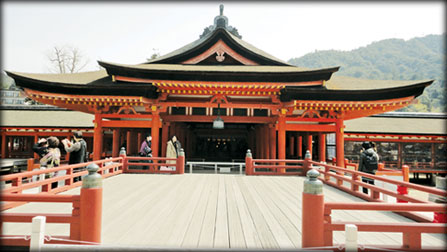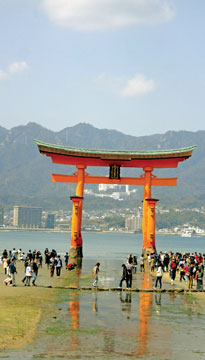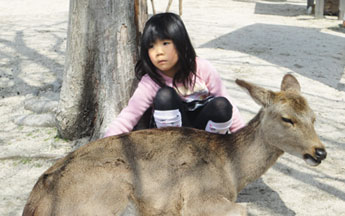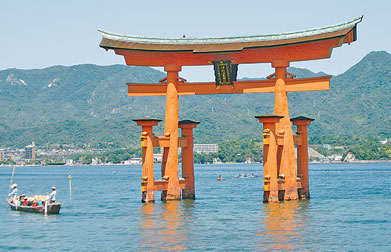|
Miyajima:
The abode of the gods
By Pramod De Silva
 |
|
The Shinto Shrine at Miyajima |
When the Ministry of Foreign Affairs of Japan invited me to visit the
country recently, an official asked me to name the city that I like to
visit most. Without any hesitation, I replied “Hiroshima”. I wanted to
make a sort of pilgrimage to the Peace Memorial there, which symbolises
the utter futility of wars between nations and the sheer destruction
caused by one of the only two atomic bombs dropped on a ‘living’ city.
Little did I realise that Hiroshima is much more than the Peace
Memorial, though it should be the main highlight of any visit to the
city, which is about 700 Km from Tokyo. My guide and interpreter told me
that a short Japan Railways ferry ride away on the Seto Inland Sea from
the Hiroshima mainland, one could see a magical, mystical island that is
often described as the ‘Place where Gods and People Live Together’.
The approach to Miyajima Island (Shrine Island in Japanese) from
Hiroshima is nothing less than stunning. The only other ferry ride that
comes close to the Hiroshima-Miyajima 10-minute ferry trip is the Star
Ferry ride from Kowloon to Hong Kong island at night, with the lit-up
Hong Kong skyscrapers almost touching the sky.
Floating on water
The first thing one notices about Miyajima is a gate that seemingly
floats on water at high tide. Called a Torii gate in Japanese, the
entrance to the island’s famous Shinto Shrine is ranked as one of
Japan’s three best picture postcard views. In fact, the island is
officially called Itsukushima, after the shrine. Like the Torii gate,
the shrine’s main buildings, including a Noh theatre, are built over
water.
 |
|
Visitors swarm around the Torii gate
at low tide |
True, Miyajima is a well-known tourist spot, but that does not make
it any less alluring. If the shrine does not entice you, there is one
other aspect of the island that will. It is perhaps the only place in
Japan where deer roam freely in the wild, but they are completely at
ease with people. One can stroke and feed them (though the latter is not
encouraged) and even protective mothers will let people cuddle their
offspring without a murmur. The island truly belongs to the deer, which
is everywhere.
“The island has a long history,” said my guide, as we walked along
the wooden planks of the Shinto Shrine (which you can enter by paying
500 Yen) while taking in the stunning views of the sea and the city of
Hiroshima across the bay. The island’s highest peak, Mount Misen was
worshipped by the local inhabitants as early as the sixth century. In
1168, Taira no Kiyomori, the most powerful man in Japan during the end
of the Heian Period, selected the island as the site of his clan’s
family shrine and built the Itsukushima Shrine.
Although I visited the shrine during daytime, many people stay
overnight at a local Ryokan (Japanese guesthouse) just to view the
colourfully illuminated shrine and the Torii gate after sunset while
enjoying a leisurely walk. However, it is not possible to enter the
shrine itself after 6 p.m. Another alternative is a boat cruise, which
enables tourists to view the illuminated island from the sea. Cruises
last over 30 minutes and take passengers around the bay and through the
Torii gate during high tide.
Tide timings
Indeed, it is better to be aware of the tide timings during a visit
to Miyajima. At high tide, the shrine and its gate appear to float above
the water. At low tide, the water drains out of the bay and visitors can
walk up to see the gate at close quarters.
In Japan, Shinto and Buddhist shrines often exist side by side,
reflecting the religious nature of the Japanese people themselves, who
often practise both philosophies. Miyajima also has a famous Buddhist
temple, a little distance away from the Shinto Shrine at the foot of
Mount Misen. Known as Daisho-in, it is one of the most important
Buddhist (Shingon Order) temples in Japan. Daisho-in features a variety
of buildings, statues and other religious objects. These include the
Kannon-do Hall, the Maniden Hall, a sand mandala made by visiting monks
from Tibet, a tea room and a cave filled with 88 Buddhist icons.
 |
|
A Japanese child pets a
deer at Miyajima |
 |
|
The Torii gate at high
tide |
That is not all. Along the temple stairs is a row of spinning metal
wheels that are inscribed with Buddhist sutras. Turning the inscriptions
as one walks up is believed to have the same effect as reading them.
Thus, even if one cannot read Japanese, one will still be blessed.
If one is up to it - literally - a hiking trail leads from the temple
grounds to the summit of Mount Misen, where more temple halls are
located. At least 90 minutes should be allocated for the hike which
promises magnificent views of the island, city and beyond. The area is
part of the Momiji-dani Park, or Maple Leaf Park which has many maple
trees.
Souvenir, curio shops
Back in town, all tourists take some time to wander in and out of the
souvenir and curio shops which sell handicraft and cloth items hand-made
by artisans in Miyajima. Such items being a rarity in most other
Japanese cities, it is better to pick up an authentic souvenir or two
from these shops. Prices are clearly marked, so language is mostly a
non-issue.
All this activity will make one hungry - and one is in the right
place. Miyajima has many delicious specialties such as fresh oysters and
conger eels caught in the Seto Inland Sea, rice cakes that are said to
increase strength and sweet-bean buns which are shaped like a maple
leaf. While there are plenty of restaurants serving freshly made
Miyajima food, it is almost impossible to get a seat at lunch or dinner
time - I actually had to get back to the mainland for lunch.
Miyajima has more surprises in store. Standing in the far western end
of Miyajima’s town area, the Miyajima Public Aquarium, improved and
reopened in August 2011, introduces fish and other aquatic creatures of
the local salt and fresh waters around Miyajima, the Seto Inland Sea and
seas and oceans around the globe. More than 13,000 varieties of fish and
marine species are on display. Among the displays is an oyster farm,
commonly seen around Miyajima island.
For someone visiting Japan, especially Hiroshima, Miyajima is an
attraction that should not be missed. It is a 10-minute trip that will
leave one with memories of a lifetime. A designated World Heritage Site,
Miyajima will leave a lasting impression as a magical island where the
mountains, sea, deer and other creatures and religious edifices blend
together in everlasting harmony. |


